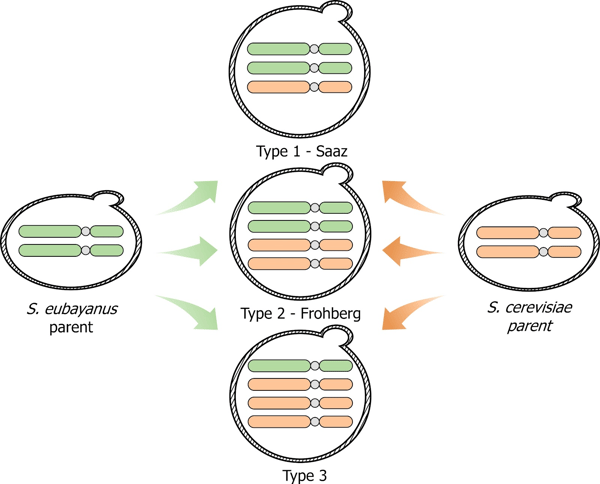One topic of active study and discussion in yeast circles recently is the hybridization event that led to the creation of lager yeast strains as we know them. Much research has focused on lager strains, and the extensive White Labs lager collection has been at the core of many of such efforts.
Latest data indicate that two main hybridization events occurred, yielding two larger groups of lager strains (Fig. 1):
- Saaz
- Includes the original strain isolated at Carlsberg. These strains contain more S. eubayanus genome than S. cerevisiae and can ferment cleaner at colder temperatures but does not ferment maltotriose.
- Frohberg
- Includes the strain originally isolated at Heineken, W34-70 and most of the commercially used strains today. Produces more aroma compounds but also drier beers.

Figure 1. Schematic of lager strains hybridization
Data from some of the large scale studies suggests that some of our strains available commercially as lager strains might not be true hybrids of Saccharomyces cerevisiae and S. eubayanus as previously determined1.2.
Hybrid S. pastorianus strains
S. cerevisiae strains
Hybrids containing significant portions of S. eubayanus genome present some very distinct physiological properties from pure S. cerevisiae strains, particularly the capacity to metabolize melibiose and the inability to grow at 37 °C.
Melibiose, a two-chained sugar connected by a ɑ-1,6 linkage. Due to this unique configuration, S. cerevisiae cannot metabolize it.
In an effort to validate these results, our R&D team implemented two methods to assess the presence of S. eubayanus genome in the strains. We targeted the known S. eubayanus genome portions using PCR and the physiological phenotype of those genome portions through a spot assay media growth at 37 °C.
Part 1 - PCR
DNA extracted from all the mentioned strains were tested using primers targeting S. eubayanus DNA regions. With WLP001 as a positive ale control and WLP820 as a positive lager control as these primers were applied successfully to the strain in previous experiments.
 Figure 2. PCR profile of the tested strains for the presence of S. cerevisiae and S. eubayanus genome contributions.
Figure 2. PCR profile of the tested strains for the presence of S. cerevisiae and S. eubayanus genome contributions.
Results
The PCR result for most strains matched the traditional classification of ale and lager. Matching the data from previous genome sequencing projects, the strains WLP051 and WLP515 appeared as hybrid strains, and WLP800 appeared as a pure S. cerevisiae strain.
However, the sequencing projects also suggest that WLP029 was a hybrid strain and that WLP838 is a pure S. cerevisiae strain. These did not match our PCR results. To investigate if the sequencing projects’ results could come from samples prepared from finished goods, the DNA was extracted from finished goods of those two strains and analyzed side by side. The results from the finished goods match the results from the working plates.
Matched with previous genome sequencing projects
Hybrids
S. cerevisiae
Different from sequencing projects
Further testing of these two strains, potentially involving sequencing of the PCR products, could contribute to establishing the correct nomenclature. However, plating these strains and growing them in the right selective conditions could be almost as powerful to identify their genotype.
Part 2 - Spot Assay
 Figure 3. Schematic representation of the spot assay. Numbers indicate different strains and letters indicate decimal dilutions of the culture.
Figure 3. Schematic representation of the spot assay. Numbers indicate different strains and letters indicate decimal dilutions of the culture.
By incubating at temperatures above 30 °C, we were able to further assess the hybrid status of the WL lager strains. The strains were tested using a spot assay on rich YPD media. Briefly, the strains were grown in liquid YPD. After adjusting the cultures to the same density(using OD600nm), various decimal dilutions of the cultures were spotted in YPD plates at the same rate (Fig. 3). The plates were inoculated and then incubated at different temperatures to evaluate temperature sensitivity. Growth at 30 °C was used as a control for the assay.
Results
 Figure 4. Growth of S. cerevisiae and S. pastorianus strains at 30 °C and 37 °C.
Figure 4. Growth of S. cerevisiae and S. pastorianus strains at 30 °C and 37 °C.
The same culture was plated in independent plates and each plate was incubated at a different temperature.
30C
- All strains presented strong growth at 30 °C, the control condition, indicating that all the cultures were healthy and that similar amounts of yeast were inoculated in each spot.
37C
- All strains classified as S. cerevisiae in our PCR analysis (WLP029 and WLP800) presented growth at 37 °C.
- All strains classified as S. pastorianus in our PCR analysis (WLP802, WLP820, WLP830, WLP833, WLP838, WLP840, and WLP860) were not able to grow at 37 °C.
- Some residual growth was observed for WLP051, WLP515, and WLP810
- No growth was observed for WLP838 at 37°C, verifying our PCR results that this strain is a hybrid and not an ale strain as reported by previous studies.
Conclusion
The data from the in-house PCR analysis and the temperature sensitivity indicate that most strains classified as lager are interspecific hybrids of S. cerevisiae and S. eubayanus. Based on our PCR analysis and temperature sensitivity assay, we validated previous research and gained more insight about some of our strains.
By understanding more about our strains, we can also learn how they can behave and ferment at various temperatures and what nuances can help them thrive to make the best fermentation possible, or it also opens the door to new possibilities.
Hybrids
S. cerevisiae
Different from sequencing projects
References
1. Langdon QK et al., "Fermentation innovation through complex hybridization of wild and domesticated yeasts.", Nat Ecol Evol, 2019 Nov;3(11):1576-1586
2. VIB/KULeuven, "Raw sequence reads of Saccharomyces strains and Saccharomyces interspecific hybrids isolated from industrial environments" 23-Jan-2019








